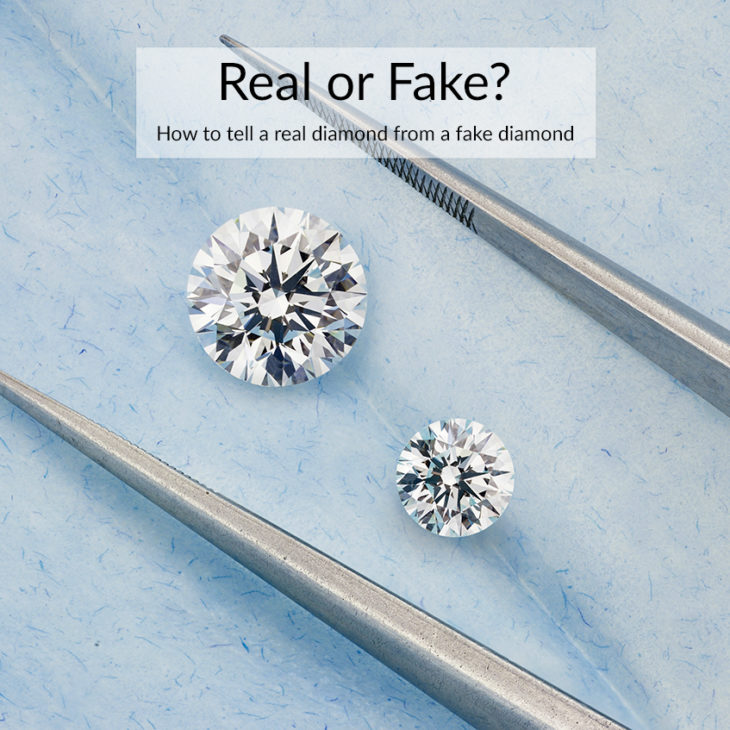How do you tell if your diamond is real?
How do you know if your diamond is real or fake? Try these eight tests at home to see if your diamond is genuine. Remember, many gemstones look very similar to diamonds and are easily mistaken for this precious gemstone.
Have you ever wondered how to tell a real diamond? How do you know if a diamond is real or fake? And, is the sparkle of your diamond from the genuine article?
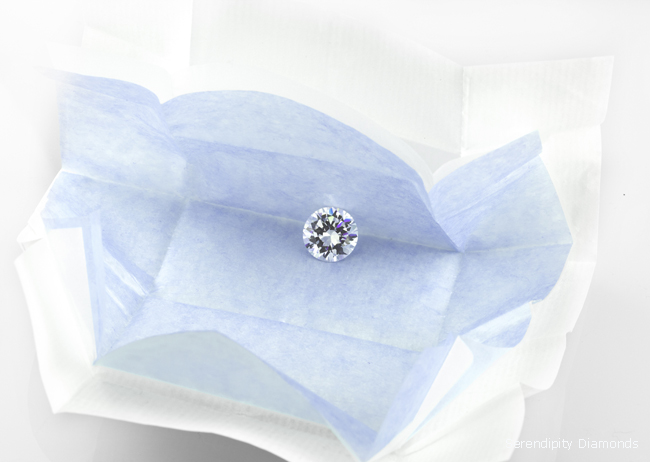
What are the different kinds of fake diamonds?
Both real and fake diamonds look very similar. Many experts use the terms simulant and synthetic diamonds to separate gems with a similar appearance into naturally occurring lookalikes (simulants) and manufactured (synthetic) diamonds, also referred to as lab-grown diamonds.
Many ‘fake’ diamonds look alike. This article reveals several ingenious ways to tell a real diamond from a fake.
You will learn to tell if your diamond is real using just one of our tests. Or is your diamond a worthless imitation? Some of the following criteria need the stone unset from the ring mount.
What are Synthetic Diamonds?
A synthetic diamond is also known as a lab-grown diamond. Other names include cultured diamond, cultivated diamond, lab-created diamond, and man-made diamond. Synthetic diamonds are produced artificially, unlike natural diamonds formed beneath the Earth. Essentially, synthetic diamonds are real diamonds. But, unlike natural diamonds, they are formed above ground by artificial means.
Please note that our tests will not identify lab-created diamonds. Most lab-grown or created diamonds include a tiny inscription identifying them as lab-grown for this reason. You might see small writing on the girdle of a real diamond or a lab-created stone. Be cautious about lab diamond rings since ‘man-made’ the laser inscription often lies beneath a claw or prong of the setting.
What are Diamond Simulants?
Diamond simulants fall into the category of imitation diamonds—stones with gemmological features similar to the real thing. Diamond Simulants differ from synthetic diamonds. In contrast, synthetic diamonds have the same material properties as natural diamonds. For this reason, most of our tests help to identify a diamond simulant from a real one.
1. The Line Test

The line test involves placing the stone on a single black line drawn on paper. It is a great way to distinguish a real diamond from a fake.
When a loose non-diamond is placed over the black line, the line can be seen through the stone. Place a real diamond over the black line and watch the line disappear. White light bends when passing through a diamond. Put simply, the higher refractive index of diamond bends light with greater effect than other non-diamonds.
2. Check the weight and size of your diamond
You can check if your loose diamond is real by weighing the stone on gemmological scales. For example, a 5mm round diamond weighs close to 0.50cts (give or take a few points.)
Diamond vs Cubic Zirconia Comparison
| Gemstone Size (mm) | Diamond Weight (carats) | CZ Weight (carats) |
|---|---|---|
| 4.0 | 0.25 | 0.43 |
| 4.5 | 0.36 | 0.61 |
| 5.0 | 0.50 | 0.80 |
| 5.5 | 0.60 | 1.15 |
| 6.0 | 0.80 | 1.50 |
| 6.5 | 1.00 | 1.75 |
However, a CZ (Cubic Zirconia) of the same size weighs far heavier, which is a straightforward sign that the stone is not a diamond. You can check the size and weight of your diamond against our online size chart.
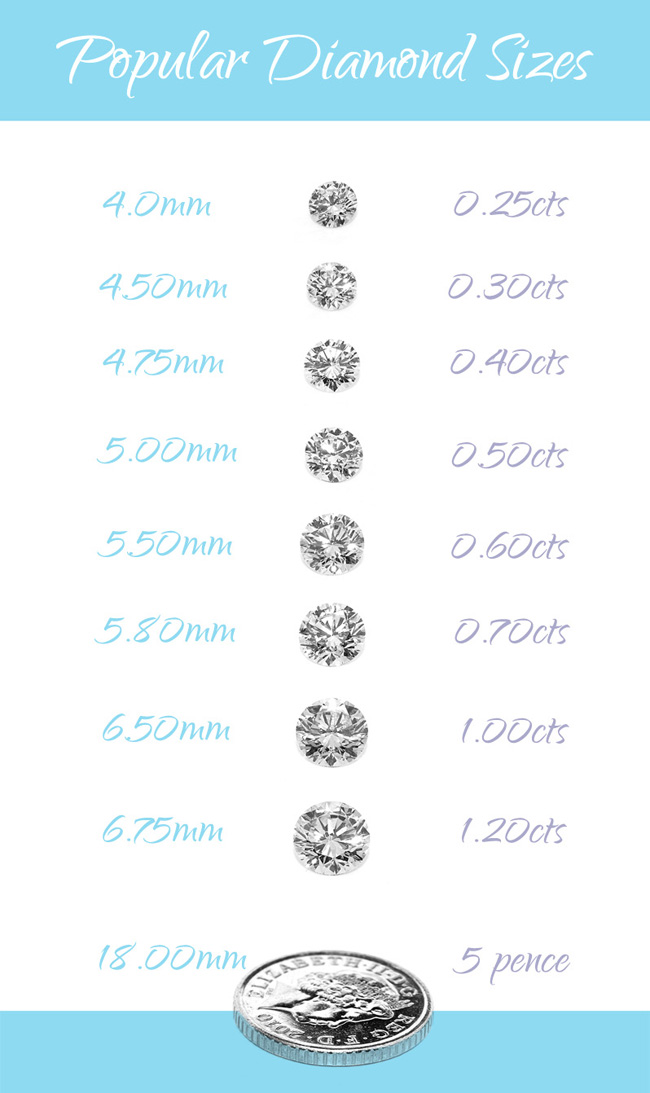
3. The breath or fog test
Some diamond experts use a breath test to spot a real diamond from a fake. When you breathe slowly on the surface of a diamond, moisture beads finely over the stone, disappearing very rapidly. The reason is thermal conductivity. The fog disappears gradually from a non-diamond. For this reason, diamonds serve a use in electronics. Lab-grown wafer-thin examples make an ideal thermal conductor for circuitry. Diamonds are the best thermal conductors on Earth.

The fog disappears gradually from a non-diamond. For this reason, diamonds serve a use in electronics. Lab-grown wafer-thin examples make an ideal thermal conductor for circuitry. Diamonds are the best thermal conductors on Earth.
4. Touching a rock with your tongue
Not strictly tasting the stone, some seasoned experts can tell a real diamond by putting it against their tongue.

This test relates to diamonds’ ability to transfer heat—put simply, their excellent thermal conductivity. Because of its thermal properties, diamonds’ icy feel is very subtle and difficult to detect.
Diamonds takesthe heat away from the surface of your tongue. Diamonds are very good at dispersing heat. For this reason, lab-grown diamond wafers make great thermal conductors for electronic circuits.
5. Does your diamond look too perfect?
Whilst flawless diamonds exist, synthetic/simulant diamonds imitate perfect bright white diamonds free of inclusions. They look too real! You could have a fake if the stone appears very white and free of any small marks. Or, you might be holding a costly diamond! CZs often appear almost purple-white compared to diamonds. For this test, you need a 10X loupe or a magnifying glass. We grade diamond colours using a scale starting at D colour. Some imitation diamonds appear too white. However, some gemstones set into Yellow Gold pick up colour from the metal colour, appearing less white. For this reason, most gems are colour-graded loose.
6. How sharp are the facets on your diamond?
Many replica stones, such as Cubic Zirconia, have more rounded edges to each facet compared to diamonds. Diamonds appear sharper and keep this sharpness. Compare a diamond to a CZ under a 10X jeweller’s lens, which will be noticeable upon looking closely.
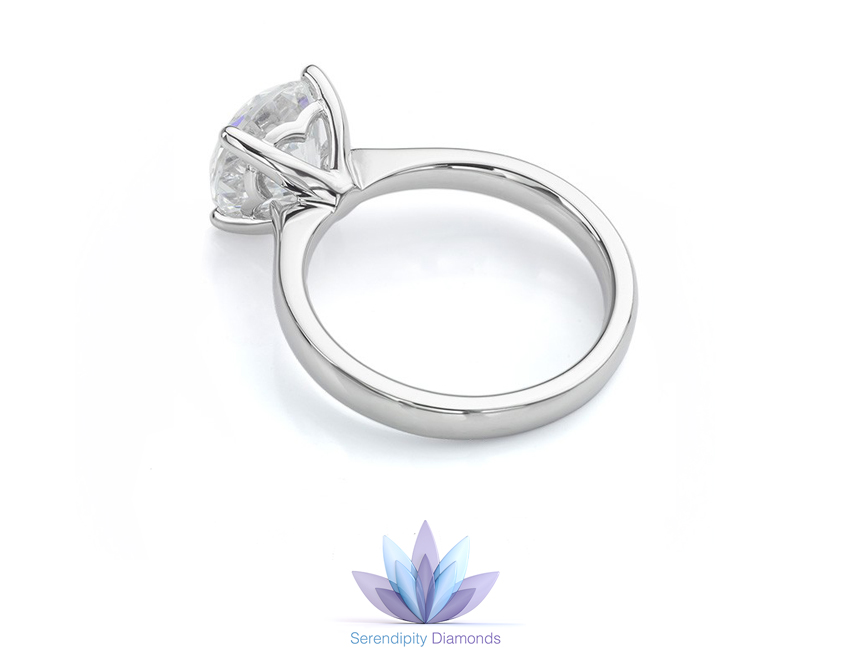
The Lila engagement ring in white gold set with a large simulant for display purposes. (From the SD showroom.)
7. Is your diamond worn?
Diamonds rarely scuff or become abraded and worn. Diamonds can sometimes appear ‘smoked’ when a stone burns under high temperature—skin results on the stone which requires polishing to remove. As a result, a smoked diamond reflects light in a reduced way with a dull surface.
Diamonds tend to keep their sharp, perfectly polished facets for life. For this reason, they outperform other gems for engagement rings. Cubic Zirconia and other replica stones wear more quickly. Non-diamonds wear on the joins between facets. This detail appears under a jeweller’s lens or magnifying glass. Do not confuse wear with chips, polish marks or natural inclusions on the surface of the diamond.
Most people know that it takes a diamond to scratch another diamond. In fact, diamonds rarely pick up scratches unless it is from another stone of the same type. On Mohs scale of hardness, diamonds are 10 on top of the list.
Rough materials such as sandpaper scratch diamond lookalikes but not real diamonds. For this reason, we refer to this test as the ‘Scratch Test’. We do not advise carrying out this test on any item unless there is no fear of damage. Most precious metals scratch easily, so be careful when considering this test.
8. Does your diamond have small marks?
Most natural diamonds have marks within the diamond. We refer to these as inclusions. If you can see small marks within your diamond, the chances are that your diamond is real and not fake.
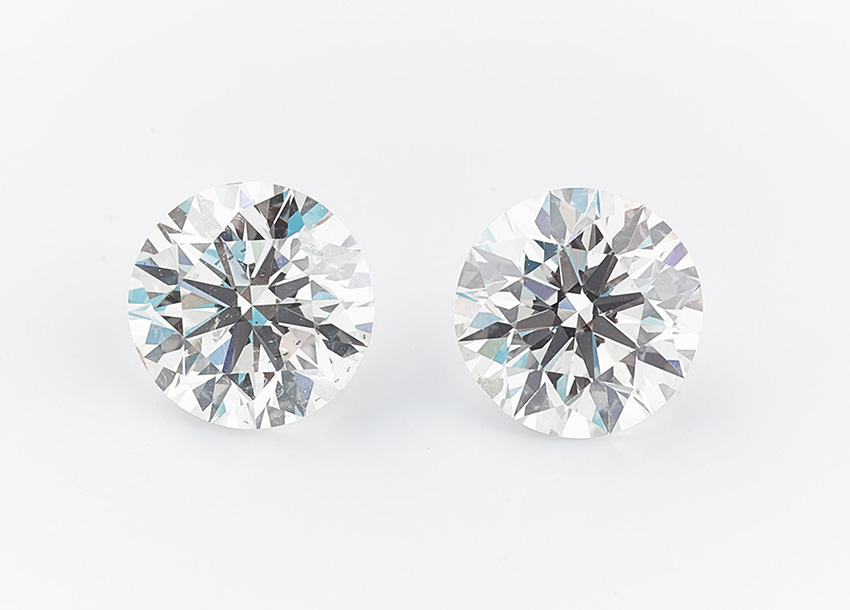
We grade diamonds 10x times magnification to grade their clarity. Many items of cheaper jewellery feature diamonds with more substantial inclusions. Some might call these natural diamonds or diamonds of a commercial grade.
Interestingly, black diamonds feature incredible amounts of natural inclusions. As a result, black diamonds exist in both natural and treated varieties.
The following galaxy black diamond ring comes from our bespoke ring gallery and reveals the density of inclusions found in many black diamond rings.
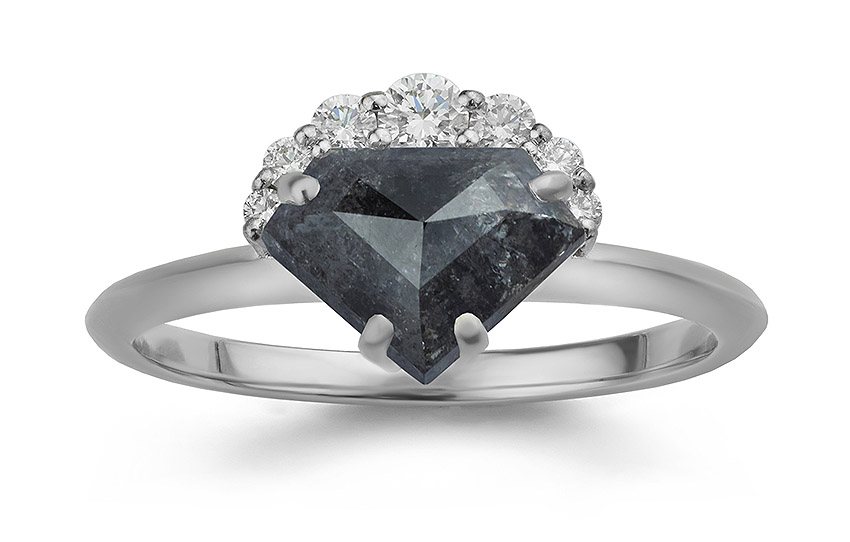
Use a fake diamond tester.
Over the years, I have used electronic diamond testers. These handy tools provide a much-needed helping hand to test a diamond. Most jewellers should keep one handy.
Even as a backup to verify their own judgement. Some diamond tester pens testers will also identify another gemstone, including Moissanite. Expect a diamond tester price to be at least £40 + £50 and avoid cheaper versions. More expensive versions exist, such as the Presidium diamond tester.
How does a diamond tester work?
Diamond testers have a metal tip at the end of the tester to determine if the stone is a real diamond. It measures thermal conductivity specific to diamonds. The sprung metal tip is pushed against the diamond or gemstone, and the LED reading shows whether the stone is a genuine diamond or not. Most devices are battery-operated and compact.
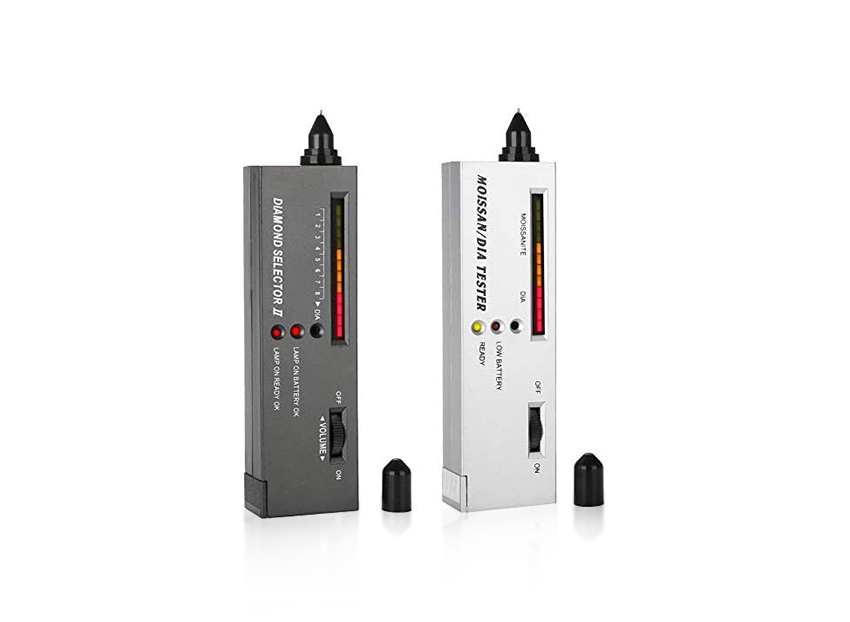
Will SI diamonds pass a diamond tester?
Yes, most definitely. SI diamonds and most included diamonds pass a diamond tester. They have the same thermal conductivity as diamonds and produce the same result when tested.
Ask an expert if you can’t tell a real diamond from a fake diamond
If you’re passing our showroom in Ryde, feel welcome to drop by. We’ll gladly test your ‘fake diamond’ to see if it is real. We test third-party ‘diamonds’ often. If your gemstone is genuine or not, we can set your stone into one of our designs. We must, however, identify your stone before any work starts. Please get in touch for a quote to set your stone into one of our many settings.
Diamond tests to avoid
Some misguided articles suggest the heat test. In this test, a diamond is heated in a flame before being dropped into cold water. Theoretically, this could prove that your diamond is real.
To explain, some synthetic gemstones may shatter as a result. However, should your diamond have internal flaws and surface breaks, a real diamond could fracture similarly. Extremes of temperature can affect a real diamond.
Why does a diamond glow under UV light?
When a diamond glows under UV light, this does not mean you have an artificial or fake diamond. Some diamonds reflect UV light in varying degrees. As a result, some diamonds appear to glow under intense UV light. Read more about diamond fluorescence on our education section of the website.
We took the following photograph of a parcel of small natural diamonds to show how some diamonds appear fluorescent under UV light. At the same time, other diamonds in the same parcel show slight or nil fluorescence.
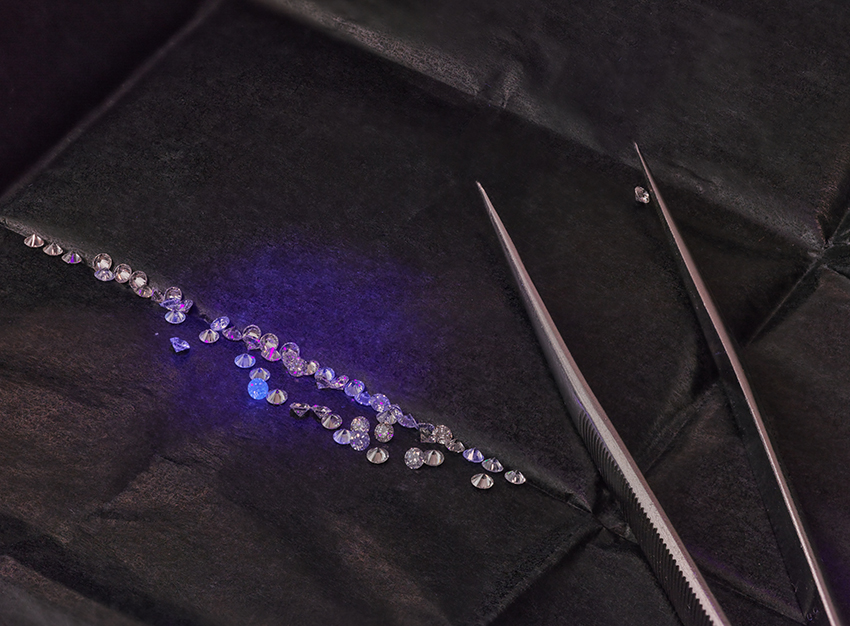
Gemstone Diamond lookalikes
For reasons of cost, some buyers search for lookalike diamond gemstones. Many transparent white gems stand in for diamonds. Some cost far less than diamonds. But many lack the hardness and dazzle of a diamond. Here are just some gemstones used as diamond substitutes.
White Topaz
White Topaz costs far less than other gemstones. Also, White Topaz occurs in various fancy shapes. Some buyers use White Topaz instead of a diamond. Real diamond shoulders work well alongside Topaz. These add an element of a ‘real diamond’ to a ring.
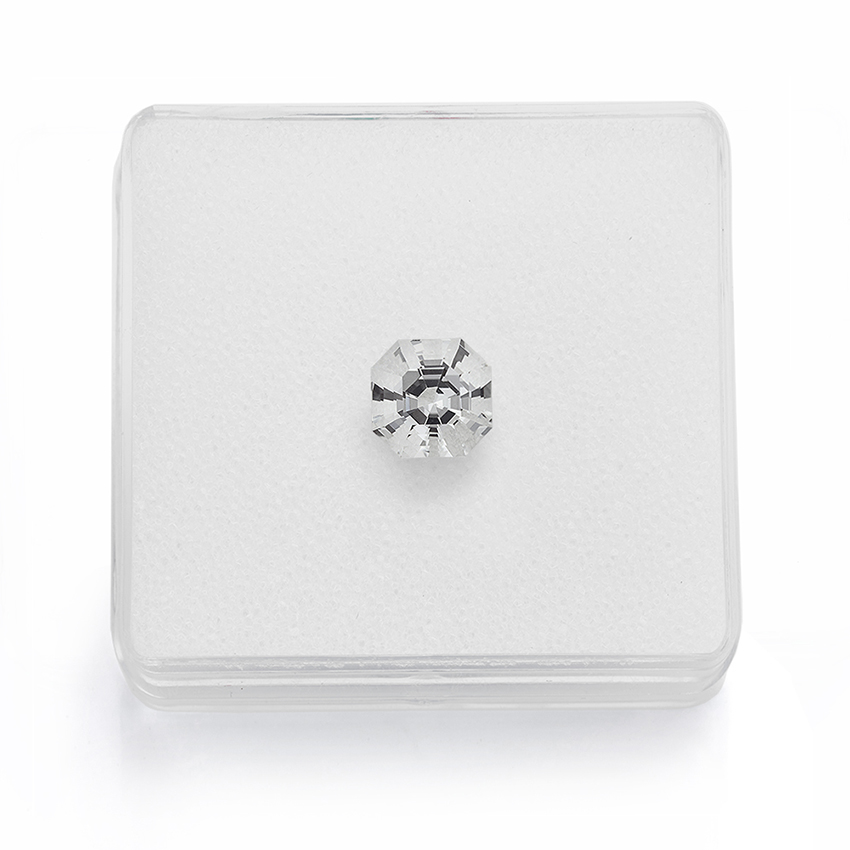
White Topaz gemstone looks very similar to a diamond.
White Sapphire
Perhaps the best fake diamond substitute. Despite White Sapphires lacking the same ‘fire’ as a diamond, they are durable. Sapphires and diamonds make tough gemstones, well suited to rings worn daily.
Moissanite
Moissanite was discovered in 1893 by the Nobel Prize-winning chemist Henri Moissan.
He found the natural form of this gemstone within a meteorite in Arizona. At first, mistaken for diamonds, he later established the crystals were formed from Silicon Carbide.
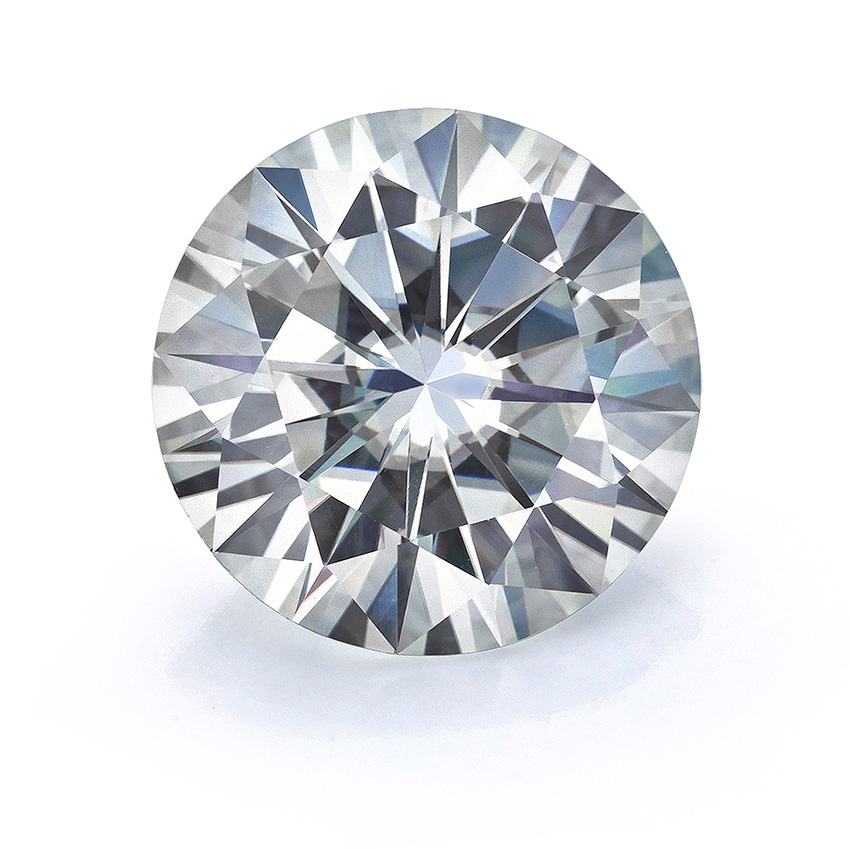
Owing to the rarity of natural Moissanite, almost all Moissanite is lab-grown. Furthermore, this diamond alternative, with visual differences, appears similar to a diamond. For example, the brilliance of both types of gemstone differ.
Compared to a diamond, Moissanite features double refraction. To the trained eye, Moissanite sparkles with additional brilliance compared to a diamond.
Moissanites provide one of the least expensive, durable alternatives to diamonds. Furthermore, their low cost makes them an attractive option for engagement ring buyers.
Learn more about our Moissanite engagement rings available at Serendipity Diamonds.
Lab-grown diamonds
Lab-grown diamonds look identical to real diamonds, with the same physical appearance and properties. For this reason, most feature an inscription on the stone’s girdle. The words “lab-grown” appear to avoid any confusion with the genuine article.
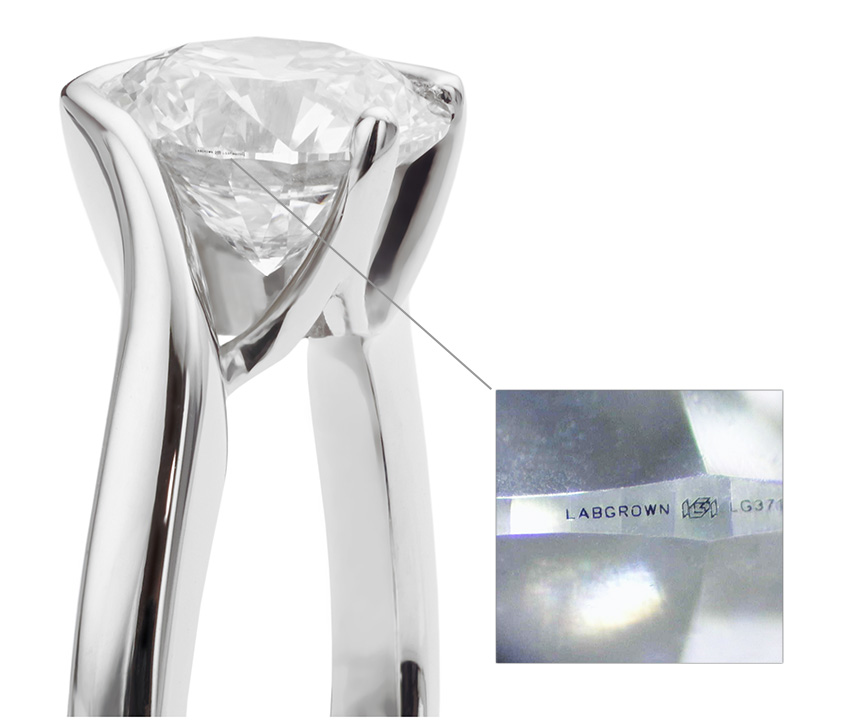
Lab-grown diamonds provide an identical alternative to natural diamonds with the same physical and chemical properties. In contrast, lab-grown diamonds work out exceptionally cheaper in their cost. For this reason, their popularity continues to soar. As a result, we introduced the option of lab-grown diamond rings in addition to their use across our showroom and website collection.
The following ring comes from our ready-made engagement rings collection and combines a large lab-grown pink diamond with natural white diamonds in each shoulder.
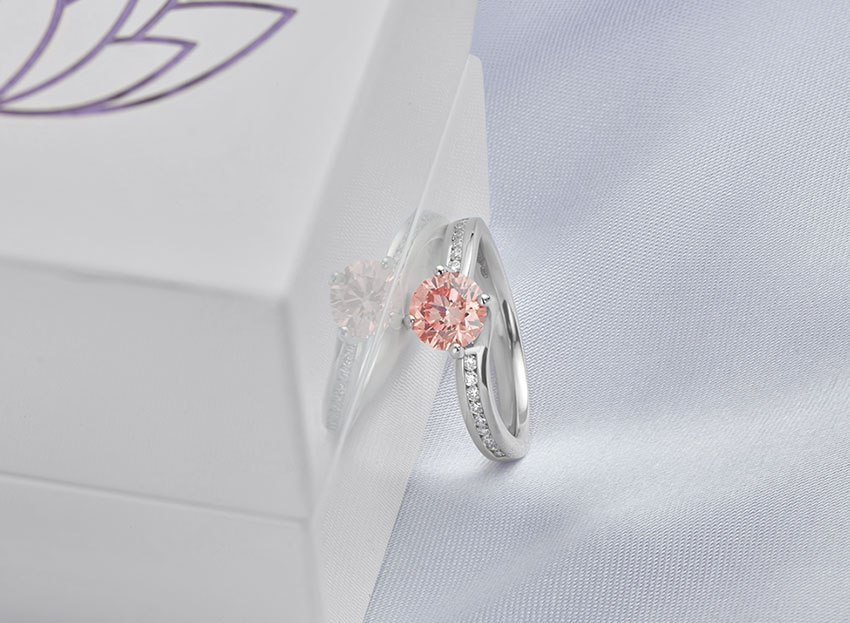
Cubic Zirconia
Many jewellers refer to Cubic zirconia by its abbreviation— CZ. Cubic Zirconia represents a cubic crystalline form of Zirconium Dioxide. Despite its visual similarity to diamond, Cubic Zirconia wears easily and lacks nearly the same durability as diamond. For this reason, many jewellers use the low-cost diamond lookalike to create replicas, try-at-home engagement rings—inexpensive versions of the real thing.
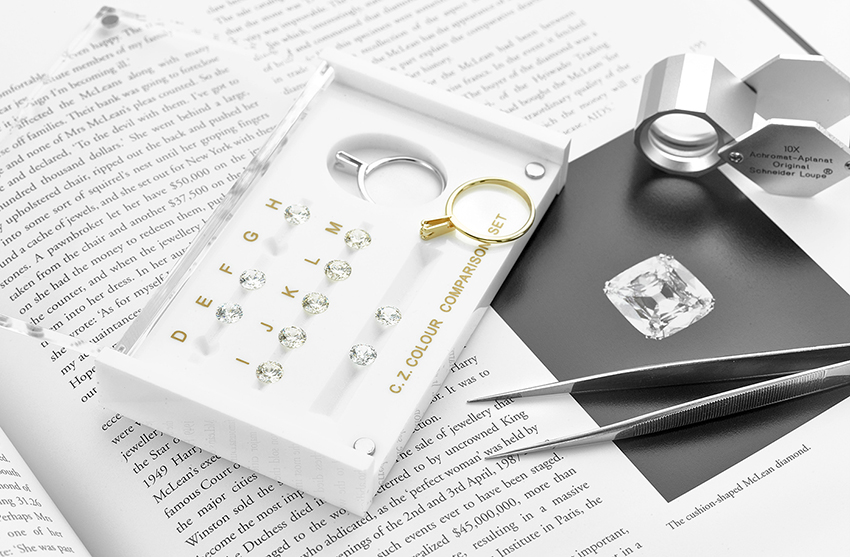
Popular for costume jewellery, CZ’s make an effective faux diamond for travel, the film industry and replica jewellery. Cubic Zirconia can be easily identified as fake by weight. Unlike diamonds, this similar-looking gemstone weighs more than an equivalent size of a diamond. In addition, see the line test above, which easily identifies a CZ owing to its poorer refraction of light.
Cubic Zirconia occurs in a variety of whiteness shades, as shown above. In fact, we use a set of CZ Master stones to demonstrate diamond colours as shown above.
Frequently Asked Questions
The best alternative to a natural diamond is a lab-grown diamond—indistinguishable from a mined diamond, approximately half the price and non-destructive to the environment.
Weigh the loose stone. Most diamond alternatives weigh differently compared to a diamond.
Diamonds provide the most durable choice of gemstone for an engagement ring. Unlike other fake diamonds, real (natural or lab-grown) diamonds rarely show signs of wear.
We recommend Moissanite as the cheapest and best diamond alternative. Moissanite provides an affordable gemstone, similar in appearance to a diamond, with equal hardness and durability.
Yes. A diamond will scratch another diamond. For this reason, diamond merchants keep larger diamonds in separate parcels.
Some diamonds exhibit varying degrees of fluorescence, but this does not indicate the diamond is fake. Larger certified diamond reports often specify fluorescence alongside the cut, colour, carat and clarity grades.
Yes, absolutely. Although diamonds offer incredible hardness, they can be broken and chipped with enough force.
Some diamonds are treated to alter their colour or to improve their clarity. For example, laser drill holes injected with acid can remove black inclusions. Or, some diamonds can be glass filled with resin to disguise flaws. Such diamonds should be specifically sold as treated and typically achieve far lower values than untreated diamonds.
About Mark Johnson
My name is Mark and I'm founder at Serendipity Diamonds. I have 30 years or experience in polished diamonds and jewellery. Today, I work with an expert team in our Isle of Wight jewellery showroom located in Ryde. Most of my work involves helping clients in our showroom, working on our two websites and photographing jewellery commissions.



